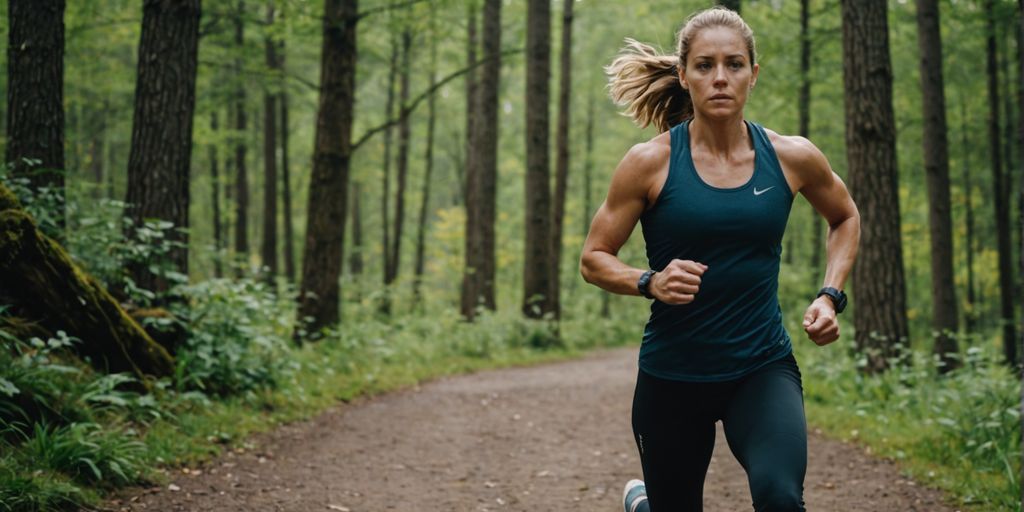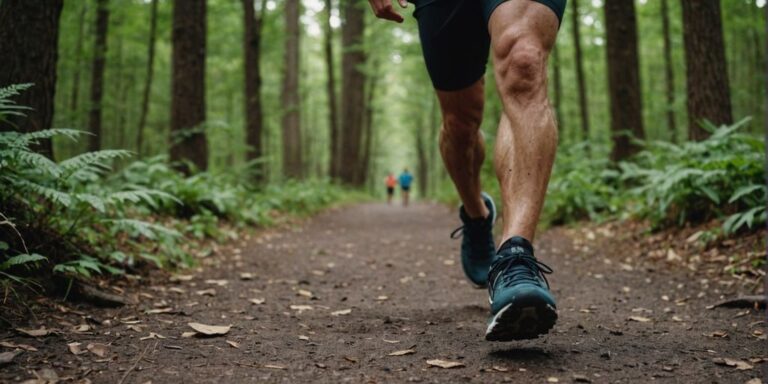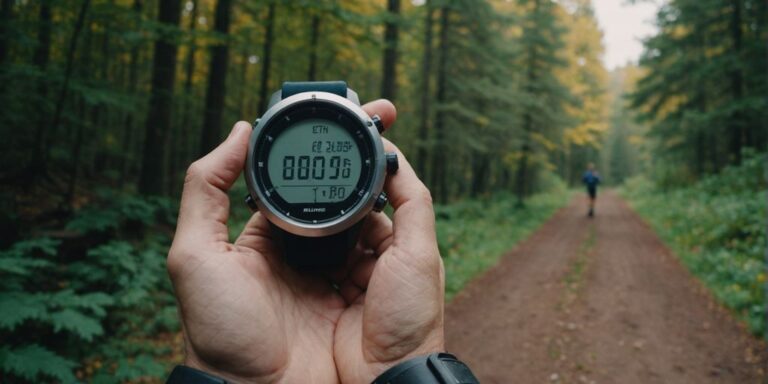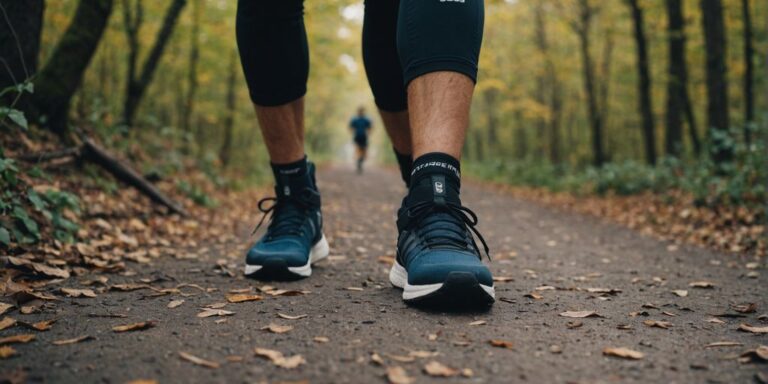Best Leg Exercises for Runners
Running is a great way to stay fit and healthy, but having strong legs is key to running well and avoiding injuries. To help runners build strength and endurance, we’ve put together a list of the best leg exercises. These exercises can be done at home and will help you run faster and longer.
Key Takeaways
- Squats are essential for building leg strength and are favored by many runners.
- Deadlifts help improve overall strength and stability.
- Walking lunges are great for balance and endurance.
- Bulgarian split squats target different muscle groups for balanced strength.
- Pistols (single leg squats) build strength and improve balance.
Squats
Squats are a fantastic exercise for runners because they work multiple joints and strengthen key muscles like the hamstrings, hips, quadriceps (quads), and glutes. These muscles are crucial for powering your stride and improving your running performance.
Common Types of Squats
- Single-leg squat: Great for balance and targeting each leg individually.
- Low-bar weighted squat: Adds resistance to build strength.
- Jump to box squat: Combines strength and explosive power.
- Overhead weight squat: Engages your core and upper body.
- Rear foot elevated squat: Focuses on the quads and glutes.
How to Perform a Basic Squat
- Stand with your feet slightly wider than hip-width apart.
- Keep your spine neutral and send your hips back and down as if sitting in a chair.
- Make sure your knees track directly over your toes throughout the movement.
- Drive back up into a standing position, maintaining good alignment.
Pro Tip: Only bend as far down as feels comfortable for your knees to avoid injury.
Incorporating squats into your routine can significantly boost your lower body strength and power, which is essential for runners. So, lace up your shoes and get squatting!
Deadlifts
Deadlifts are a powerhouse exercise that every runner should consider adding to their routine. They help strengthen the hamstrings, glutes, and back, which are crucial for maintaining good posture and stability during runs. Improved posture can prevent injuries and enhance performance, especially on hills.
To perform a deadlift, follow these steps:
- Place your feet under the bar, slightly narrower than shoulder-width.
- Point your toes outward, similar to a squat.
- Keep the bar close to your body to maintain stability.
- Grab the bar with an overhand grip.
- Lift the bar by pushing through your heels, keeping your lower back slightly arched.
- At the top, squeeze your glutes and stand upright.
- Lower the bar in a controlled manner by pushing your hips back and then bending your knees.
If you haven’t tried deadlifts before, it’s time to incorporate them into your training routine. They offer dynamic exercises to enhance running performance, prevent injuries, and improve stability and form.
Walking Lunges
Walking lunges are a fantastic exercise for runners, targeting the front thigh, back thigh, and glutes. They help improve flexibility and strength, which is essential for a balanced and injury-free running routine.
Here’s how to perform walking lunges:
- Hold a dumbbell in each hand.
- Step forward with your left leg and lower your body until your front knee is at a 90-degree angle.
- Lower your back knee toward the floor.
- Push through your front leg to bring your back leg forward and repeat the movement with the opposite leg.
With walking lunges, aim for a higher volume, such as 10 reps per leg. This exercise not only strengthens your legs but also enhances your range of motion in the hip flexors, which can become tight from repetitive running.
Pro Tip: Choose comfortable shoes that suit your needs and preferences for a confident run.
Bulgarian Split Squat
The Bulgarian Split Squat is a fantastic exercise for runners. This move not only builds strength but also enhances balance, flexibility, and muscular symmetry. You’ll need a sturdy chair, bench, or couch to perform this exercise.
- Stand a few feet in front of the bench and place one foot behind you on the bench.
- Lower your body until your front thigh is parallel to the ground.
- Push back up to the starting position.
Be sure to keep your back straight and your core engaged throughout the movement. This exercise targets your quads, glutes, hamstrings, and calves, making it a comprehensive lower body workout.
Mastering the Bulgarian Split Squat can significantly improve your running performance by enhancing your lower body strength and stability.
Pistols (Single Leg Squats)
Pistols, or single-leg squats, are a fantastic exercise for runners. They help to strengthen your hips, quads, glutes, and hamstrings. Plus, they improve your balance and coordination, which is crucial for running. The primary benefit of a single-leg squat is to build strength in your lower body.
Technique
- Stand with your feet hip-width apart.
- Extend one leg out in front of you.
- Slowly lower your body down, keeping your extended leg off the ground.
- Push back up to the starting position.
- Repeat on the other leg.
Be sure to keep your back straight and look forward to maintain balance.
Pistols mimic the movement patterns used during running, making them a functional exercise that will improve your running strength.
Calf Raises with Eccentric Drop
Calf raises with eccentric drop are a fantastic way to strengthen your calves, feet, and Achilles. This exercise also helps improve lower leg stability, which is crucial for runners. You can do this exercise on the floor or on a step for added difficulty.
- Stand with your toes on a step, feet hip-distance apart, and weight evenly distributed. Hold onto a rail for support.
- Slowly lift your heels up high and hold for a moment.
- Lower your heels down beyond your neutral starting point for an eccentric drop.
- Return to the starting position and repeat.
This exercise is great for giving your lower legs a recovery boost after a long run. It helps reduce strain on your Achilles tendon and shins.
For an extra challenge, try doing this exercise on one leg at a time. This will increase the intensity and further strengthen your calves and feet.
Single Leg Calf Raises with Eccentric Drop

Single leg calf raises with eccentric drop are a fantastic way to boost the strength of your calves, feet, and Achilles. This exercise also helps improve lower leg stability, which is crucial for runners. The eccentric heel drop is a key part of this movement, where you focus on the lowering phase when the muscles lengthen.
To perform this exercise:
- Stand on a step with your toes, keeping your heels off the edge.
- Shift your weight to one leg, making sure you feel secure.
- Slowly lift your heel as high as you can and hold for a moment.
- Lower your heel down beyond the starting point for an eccentric drop.
- Return to the starting position and repeat.
This exercise might look simple, but it’s highly effective for building strength and stability in your lower legs. Give it a try and feel the difference in your running performance!
Reverse Lunges

Reverse lunges are a fantastic exercise for runners. They help activate your glutes, hamstrings, and core while putting less stress on your joints compared to forward lunges. Here’s how to do them:
- Stand tall with your feet shoulder-width apart and place your hands on your hips or overhead.
- Take a large step back so your front knee is directly over your ankle.
- Lower your hips until your front quad is parallel to the floor.
- Push forward with your back leg to return to the starting position.
- Switch legs and repeat.
This exercise is great for improving balance and stability, which are crucial for runners.
Remember, consistency is key to seeing results.
Jumping Lunges
Jumping lunges are a fantastic way to activate and strengthen your quads, hips, and glutes. They also help improve stability and coordination. This movement is similar to walking lunges but includes a jumping transition to increase intensity. If you’re new to lunges, it’s best to master the walking lunge before attempting the jumping lunge.
How to Perform Jumping Lunges
- Stand tall with your feet shoulder-width apart and arms bent.
- Take a large step forward with your right leg and lower into the lunge position, ensuring your right knee is over your right ankle and your left arm is forward.
- Lower your hips to bring your right quad parallel to the ground.
- Prepare to jump. Propel yourself upward, bringing your left foot forward and your right leg back for the landing. Switch arms as you switch legs.
- Alternate sides for the remainder of the set.
Jumping lunges are a great way to improve your running performance by enhancing your leg strength and coordination. They also help in building core muscles and improving joint health.
Box Jumps
Box jumps are a fantastic exercise to build explosive power in your glutes and strengthen your quads. They also help raise your heart rate, making them a great cardio workout. To get started, you’ll need a plyometric box or a high step.
- Start with your feet shoulder-width apart. Bend your knees and hips slightly, and swing your arms back.
- Push off the ground with your legs and swing your arms forward to jump onto the box.
- Land softly in a partial squat, absorbing the impact with your glutes and hamstrings.
- Keep your back flat, chest up, and knees tracking over your toes.
Remember, jumps with proper form should be quiet. This means you’re landing softly and absorbing the impact correctly.
Box jumps are not just about jumping high; they also boost your agility, cardiovascular endurance, and total body strength. So, grab a box and start jumping to see the benefits!
Conclusion
Building strong legs is key for any runner. The exercises we’ve talked about can help you run faster, longer, and with less risk of injury. Whether you’re training for a marathon or just running for fun, adding these moves to your routine can make a big difference. Start slow, listen to your body, and gradually increase the intensity. Soon, you’ll notice your legs getting stronger and your runs getting better. Happy running!
Frequently Asked Questions
Why are squats important for runners?
Squats help build strong leg muscles, which are essential for better running performance. They improve balance and stability, making you a more efficient runner.
How often should I do deadlifts as a runner?
It’s a good idea to include deadlifts in your workout routine 1-2 times a week. This helps build strength without overworking your muscles.
Can I do walking lunges at home?
Yes, walking lunges can easily be done at home. You don’t need any special equipment, just a bit of space to move around.
What are Bulgarian split squats good for?
Bulgarian split squats target your quads, hamstrings, and glutes. They help improve balance and strength in your legs, which is great for running.
Are calf raises with eccentric drop useful for runners?
Absolutely! Calf raises with eccentric drop strengthen your calves and improve ankle stability, which can help prevent injuries.
How can I make box jumps safer?
To make box jumps safer, start with a lower box and focus on landing softly. Always warm up before doing them to reduce the risk of injury.







One Comment